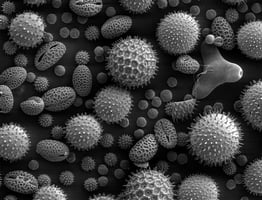Manufacturing facilities and other large warehouse environments have a variety of unique...
Avoid Sick Building Syndrome with HVLS Fans

Sick building syndrome (SBS) is a common malady recognized by the National Safety Council and identified as:
- Occupants of a building incur bad health effects connected to time spent in the building.
- Symptoms connected to a specific room or area of the building.
- A building that may be maintained poorly or used inconsistently with the original design.
Symptoms
In addition to acute discomfort, which can lead to absenteeism and reduced productivity, the symptoms of sick building syndrome include irritation of the eyes, nose, and throat, acute headaches, dizziness and nausea, dry itchy skin, and/or dry cough. Additionally, employees could experience psychological symptoms such as sensitivity to odors, fatigue, and difficulty in concentration.
Where Does It Come From?
If employees are sick but feel better when they leave the facility, there may be a contaminant somewhere in the building. Poor ventilation is one of the main causes of sick building syndrome; other factors include the following.
-
Indoor Air Pollution:
- Manufacturing plants that use chemicals, astringents, cleaning supplies, glues, and fuels can affect indoor air quality. Regardless of whether these chemicals are a by-product of operations or used to keep the operation clean, employees can inhale them.
- Agriculture operations using pesticides can sicken people or animals.
- Air conditioning systems do not properly mix or clean indoor air.
-
Outdoor Air Pollution That Drifts Indoors:
- Motor vehicle and building exhaust, combustion fumes, tobacco smoke, and other pollutants can enter a building as easily as fresh air does and can be inhaled.
-
Biological Toxins:
- Bacteria, viruses, molds, mildew, pollen, and other allergens gather and breed in standing water, ducts, and humidifiers. Bacteria tend to settle into fabrics, ceiling tiles, carpets, and insulation and can be a hazard.
What to Do?
The problem, cause, symptoms, and diagnostic tests to identify sick building syndrome are complex because symptoms may be responses to any number of things. However, most experts agree the cause is mainly due to poor air quality, and lack of proper ventilation and circulation.
In order to see what the cause is, tests can be run to identify and isolate toxic gasses, bacteria, molds, and other recognized compounds. The Occupational Safety and Health Administration (OSHA) has published standards that generally cover the causes and conditions of air pollution, and recommend installing improved filters in air conditioning units and conducting routine air conditioning maintenance checks to improve air quality and reduce particulates.
Additionally, heating and air conditioning systems may not be adequate for the building’s use. The system should comply with the American Society of Heating, Refrigerating and Air Conditioning Engineers (ASHRAE) recommendations.
Ventilation Is the Key
Macro Air high volume, low speed (HVLS) fans are the best solution for increased indoor air quality. The company’s aerodynamic blades are 6 to 24 feet in diameter and produce large columns of air that go down to the floor and move out in a floor jet circulation of 360 degrees.
This process de-stratifies the air and changes its molecular structure, which cools the environment and relieves humidity. HVLS fans can be positioned to improve general air quality and temperature or to process the air in and near areas of known pollutants. MacroAir HVLS fan can help:
- Reduce energy costs by 20 percent.
- Minimize humidity and the related bacteria.
- Reduce or eliminate ducts.
- Improve natural ventilation and exhaust polluted air.
Check out MacroAir’s HVLS fans and learn what fan is the best choice for your facility and how it can help cure sick building syndrome in a cost-effective way.

